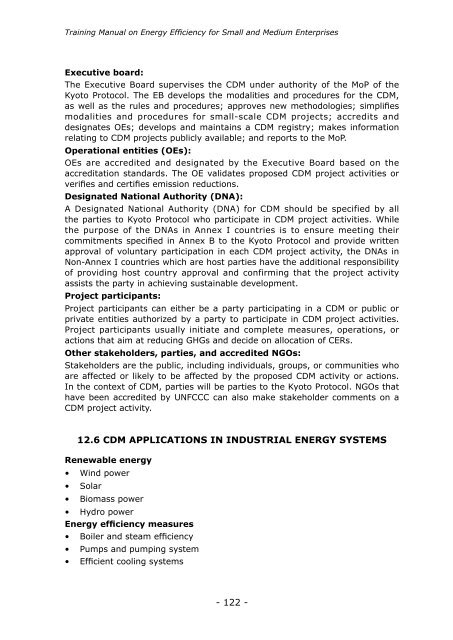Training Manual on Energy Efficiency - APO Asian Productivity ...
Training Manual on Energy Efficiency - APO Asian Productivity ...
Training Manual on Energy Efficiency - APO Asian Productivity ...
Create successful ePaper yourself
Turn your PDF publications into a flip-book with our unique Google optimized e-Paper software.
<str<strong>on</strong>g>Training</str<strong>on</strong>g> <str<strong>on</strong>g>Manual</str<strong>on</strong>g> <strong>on</strong> <strong>Energy</strong> <strong>Efficiency</strong> for Small and Medium Enterprises<br />
Executive board:<br />
The Executive Board supervises the CDM under authority of the MoP of the<br />
Kyoto Protocol. The EB develops the modalities and procedures for the CDM,<br />
as well as the rules and procedures; approves new methodologies; simplifies<br />
modalities and procedures for small-scale CDM projects; accredits and<br />
designates OEs; develops and maintains a CDM registry; makes informati<strong>on</strong><br />
relating to CDM projects publicly available; and reports to the MoP.<br />
Operati<strong>on</strong>al entities (OEs):<br />
OEs are accredited and designated by the Executive Board based <strong>on</strong> the<br />
accreditati<strong>on</strong> standards. The OE validates proposed CDM project activities or<br />
verifies and certifies emissi<strong>on</strong> reducti<strong>on</strong>s.<br />
Designated Nati<strong>on</strong>al Authority (DNA):<br />
A Designated Nati<strong>on</strong>al Authority (DNA) for CDM should be specified by all<br />
the parties to Kyoto Protocol who participate in CDM project activities. While<br />
the purpose of the DNAs in Annex I countries is to ensure meeting their<br />
commitments specified in Annex B to the Kyoto Protocol and provide written<br />
approval of voluntary participati<strong>on</strong> in each CDM project activity, the DNAs in<br />
N<strong>on</strong>-Annex I countries which are host parties have the additi<strong>on</strong>al resp<strong>on</strong>sibility<br />
of providing host country approval and c<strong>on</strong>firming that the project activity<br />
assists the party in achieving sustainable development.<br />
Project participants:<br />
Project participants can either be a party participating in a CDM or public or<br />
private entities authorized by a party to participate in CDM project activities.<br />
Project participants usually initiate and complete measures, operati<strong>on</strong>s, or<br />
acti<strong>on</strong>s that aim at reducing GHGs and decide <strong>on</strong> allocati<strong>on</strong> of CERs.<br />
Other stakeholders, parties, and accredited NGOs:<br />
Stakeholders are the public, including individuals, groups, or communities who<br />
are affected or likely to be affected by the proposed CDM activity or acti<strong>on</strong>s.<br />
In the c<strong>on</strong>text of CDM, parties will be parties to the Kyoto Protocol. NGOs that<br />
have been accredited by UNFCCC can also make stakeholder comments <strong>on</strong> a<br />
CDM project activity.<br />
12.6 CDM APPLICATIONS IN INDUSTRIAL ENERGY SYSTEMS<br />
Renewable energy<br />
• Wind power<br />
• Solar<br />
• Biomass power<br />
• Hydro power<br />
<strong>Energy</strong> efficiency measures<br />
• Boiler and steam efficiency<br />
• Pumps and pumping system<br />
• Efficient cooling systems<br />
- 122 -
















